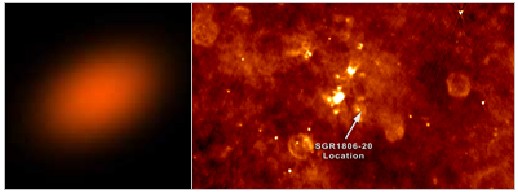[ Skywatchers ] [ Main Menu ]
47219

From: Eve, [DNS_Address]
Subject: Gamma Ray Burst 02-23A-2023
URL: SKY MAP
|
Constellation Sagittarius |
47220

From: Eve, [DNS_Address]
Subject: Re: GRB 02-23A-2023 = location of Magnetar SGR 1806-20 !!!
|
These are the coordinates I picked up from the circular for the gamma ray burst which is substantial per the graph in previous post: right ascension = 18h 10m 01s declination = - 20 deg. 23' 42" (south) Here are the actual location of the Magnetar SGR 1806-20: right ascension = 18h 08m 39.32s declination = -20 deg. 24' 39.5 (south) -------------------------------------------------------------------------------------------------------------------------------------------------------------------------------------------------- Memories of chatter regarding gravity wave concerning the 2004 Indonesia earthquake resurfaced. A few days ago I posted on this board of another large GRB in constellation Sagittarius....The exact location listed was not that of SGR 1806-20 but it was in the vicinity. Date: February 17, 2023 at 21:40:46 From: Eve Subject: Gamma Ray Burst 02-17A-2023 -- Constellation Sagittarius URL: sky map link to post with graph from grb on 2-17-23: http://earthboppin.net/talkshop/space/messages/47212.html -------------------------------------------------------------------------------------------------------------------------------------------------------------------------------------------------- EXCERPT: SGR 1806−20 is a magnetar, a type of neutron star with a very powerful magnetic field, that was discovered in 1979 and identified as a soft gamma repeater. SGR 1806−20 is located about 13 kiloparsecs (42,000 light-years)[1] from Earth on the far side of the Milky Way in the constellation of Sagittarius. It has a diameter of no more than 20 kilometres (12 mi) and rotates on its axis every 7.5 seconds (30,000 kilometres per hour (19,000 mph) rotation speed at the surface). As of 2016, SGR 1806-20 is the most highly magnetized object ever observed, with a magnetic field over 1015 gauss (G) (1011 tesla) in intensity[2] (compared to the Sun's 1–5 G and Earth's 0.25–0.65 G). Explosion Fifty thousand years after a starquake occurred on the surface of SGR 1806-20, the radiation from the resultant explosion reached Earth on December 27, 2004 (GRB 041227).[3] In terms of gamma rays, the burst had an absolute magnitude around −29.[a] It was the brightest event known to have been sighted on this planet from an origin outside the Solar System, until the GRB 080319B. The magnetar released more energy in one-tenth of a second (1.0×1040 J) than the Sun releases in 150,000 years (4×1026 W × 4.8×1012 s = 1.85×1039 J).[4] Such a burst is thought to be the largest explosion observed in this galaxy by humans since the SN 1604 supernova observed by Johannes Kepler in 1604. The gamma rays struck Earth's ionosphere and created more ionization, which briefly expanded the ionosphere. A similar blast within 3 parsecs (10 light years) of Earth would severely affect the atmosphere,[5] by destroying the ozone layer and causing mass extinction,[6][7] and be similar in effect to a 12-kiloton nuclear blast at 7.5 kilometres (4.7 mi).[citation needed] The nearest known magnetar to Earth is 1E 1048.1-5937, located 9,000 light-years away in the constellation Carina.  misc. https://ochiaisoup.bandcamp.com/album/sgr-1806-20 |
47221
From: Eve, [DNS_Address]
Subject: Re: GRB 02-23A-2023 = location of Magnetar SGR 1806-20 !!!
|
An article link regarding starquakes mentions SGR 1806-20 gamma ray burst in 2005: https://www.thedailybeast.com/thousands-of-tsunami-sized-starquakes-detected-across-space-by-the-european-space-agencys-gaia |
47222
From: Eve, [DNS_Address]
Subject: Re: GRB 02-23A-2023 = location of Magnetar SGR 1806-20 !!!
|
another article link for reference: The SGR 1806-20 magnetar signature on the Earth's magnetic field https://academic.oup.com/gji/article/167/2/586/562042 |
Responses:
[47223]
47223
From: Eve, [DNS_Address]
Subject: Re: GRB 02-23A-2023 = location of Magnetar SGR 1806-20 !!!
|
This is a 13 year old clip, interesting nonetheless. Magnetosphere & SGR 1806 20 Super Burst 35,063 views Apr 3, 2009 I have reconstructed the data from this event from 12-27-2004 . Known as the Super Burst , It was from Source SGR1806-20 a ultra-magnetic neutron star -- magnetar. In this movie is the Nict Simulation for the day , And it is noteworthy that the activity that has occurred in 2009 also from a Neutron Star would suggest the recent Burst are either closer or they are stronger then this Super Burst from 2004.The magnetic field more or less snapped in a process scientists call magnetic reconnection except this was not due to the Sun but from a Cosmic Burst.The magnetic field around a neutron star -- magnetar. is about 1,000 trillion gauss, strong enough to strip information from a credit card at a distance halfway to the Moon.Gamma rays are the highest form of radiation on the electromagnetic spectrum, which includes X-rays, visible light and radio waves too.The star, named SGR 1806-20, spins once on its axis every 7.5 seconds, and it is surrounded by a magnetic field more powerful than any other object in the universe. The result of this burst saw a massive release of magnetic energy .The blast was 100 times more powerful than any other similar eruption witnessed up till now. The explosion that was halfway across the galaxy packed so much power it briefly altered Earth's upper atmosphere. The event equaled the brightness of the full Moon's reflected visible light, |
Responses:
None
[ Skywatchers ] [ Main Menu ]